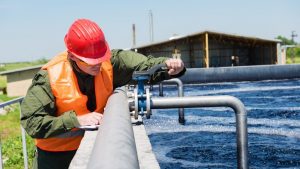Systems that rely largely on plants to treat wastewater, cleaning it enough that it can be put to other uses, have been described as “design-intensive.”
Systems that rely largely on plants to treat wastewater, cleaning it enough that it can be put to other uses, have been described as “design-intensive.”
After all, if you’re going to have such a system in the lobby of an office building (like one in Portland, Ore.) it mustn’t smell, and the plants must not only be healthy, they must look healthy.
There are several systems on the market, and Solar Aquatics and Living Machines are perhaps the best known. But designers have to tweak those systems to meet local conditions.
While some details vary from system to system (using sand filtration vs. crushed lava, for example) there are more similarities than differences.
The objective is to mimic the purification processes of freshwater wetlands. That means that, besides a wide variety of plants, aquatic animals (zooplankton and snails) and bacteria come into play.
Air is pumped through the wastewater to encourage bacteria grow on plant roots. The bacteria “digest” many of the solids. Remaining solids are settled by gravity, and pumped as needed to a sludge digester to be stabilized. The stabilized solids are finally taken away to be composted.
The waste stream flows through sand filters that remove any remaining solids, then into wetlands built indoors. These wetlands often take the form of large tanks heavily planted with a variety of aquatic plants. There biological treatment continues as contaminants are metabolized.
More filtration, followed by disinfection by exposure to ultraviolet light, and the wastewater is clean enough for further use.
It can be pumped into wells to recharge groundwater, it can be used for irrigation on the building site, for fish farming, for any use that doesn’t require potable water.
It takes wastewater three or four days to pass through the system.
Since temperature is critical to the efficient operation of such systems, greenhouses are often used in cool climates to enhance the growth of algae, plants, bacteria and aquatic animals. In hot climates, shade houses are often used.
Choice of plants for use in these systems can also be critical. Some plants accumulate metals in their cells; different plants bind different metals.
Also, plants that are attractive as pond plants are also beneficial, since they can be propagated and sold as starters to people looking for plants for home ponds.










Recent Comments
comments for this post are closed